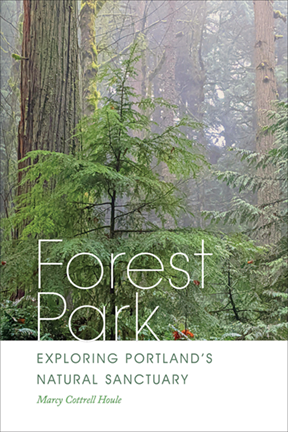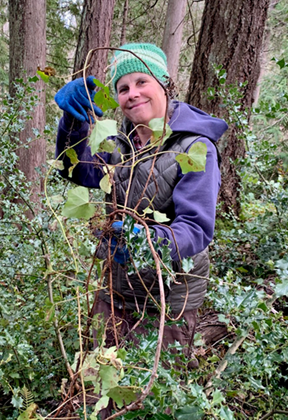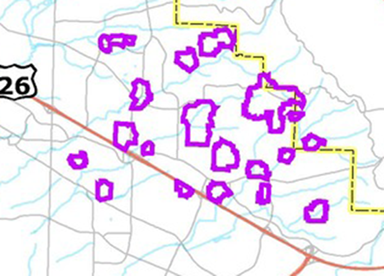Garden & Nature February 2024

- Forest Park History and Ecology
- Washington County Master Gardener programs
- Blueberry Care
- Treekeepers of Washington County programs
- Tree Walk: Jenkins Estate
- Find Oregon White Oak Habitat in Washington County
- Spring Native Sale at Nature Center
- Let’s Grow Together! Webinars
- 2023 Japanese Beetle Eradication Update
Forest Park History and Ecology
Thursday, February 22, 7 pm, Skyline Memorial Gardens, 4101 NW Skyline Blvd, free, open to all

Forest Park Neighborhood Association is delighted to announce that Marcy Cottrell Houle will speak about the history and ecology of Forest Park. Marcy is a biologist who has studied the park for many years and the author of our favorite books about the park. She is also an entertaining speaker and storyteller.
Situated in the rugged hills west of downtown Portland, Forest Park is the nation’s premier urban natural sanctuary. It supports essential habitat for hundreds of native plants and animals, including species at risk, and is one of the largest city parks in the world, offering miles of outstanding hiking trails within minutes of downtown.
In the introduction to her most recent book, Forest Park: Exploring Portland’s Natural Sanctuary, Marcy writes: “After studying Forest Park as an author and wildlife biologist for over four decades, my appreciation of its value only continues to grow…offering a place where our spirits can be touched by something greater than ourselves.”
After Marcy’s talk, we will learn about a PGE proposal to clear-cut six acres of mature forest canopy inside Forest Park from a member of Forest Park Conservancy. For questions, contact Carol Chesarek, Forest Park Neighborhood Board Member.
Washington County Master Gardener programs
Conserving Invertebrates at Home
Tuesday, March 5, 7-8 pm, Zoom, register here, free
Join us for a Zoom Webinar on ways to conserve invertebrates in the home garden. Populations of many insect species are declining, but home gardeners can play an important role in their conservation, as yards are well positioned to provide habitat for these species. Learn how to create year-round invertebrate habitat, including resources and shelter, the risks pesticides pose to invertebrates at home, and tips to protect your garden habitat from contamination.
Aaron Anderson works with the public and Xerces staff to reduce pesticide use in residential landscapes, including promoting alternative pest control measures and pollinator-friendly gardening practices. Prior to joining Xerces in 2022, he researched pollinator conservation in urban landscapes, restored habitat for several endangered butterfly species, and worked in insect biocontrol. Aaron received his PhD from Oregon State University
Blueberry Care
Saturday, February 17, 10-noon, PCC Rock Creek Campus Bldg. 7, Room 105, and PCC Rock Creek Learning Garden 17705 NW Springville Rd.
Blueberries are easy and fun to grow. Join the WCMGA to learn about planting, fertilizing, plant selection and care for blueberries, including pruning techniques. Bring your own hand pruners and garden gloves for some hands-on opportunity to prune. This class will be led by OSU Ext. Master Gardener Volunteers Sue Ryburn, Helen Dorbolo, Lisa Barnhart, and Susan Albright. For more information please visit the webpage.
The Washington County Master Gardener™ Association (WCMGA) sponsors a wide variety of gardening–related demonstrations, lectures, seminars and workshops in various Washington County Oregon locations. Most of our events are free and open to the public. The WCMGA is a 501c3 non-profit supported by hundreds of volunteers, who work to educate the public about sustainable, affordable gardening.
Treekeepers of Washington County programs
We work to protect and advocate for trees in urban unincorporated Washington County. Don’t miss our upcoming events! All of them are free. Visit our website to learn more.
Tree Walk: A Short Lope in Bonny Slope
Sunday, February 18, 10 am, Bonny Slope Elementary School, 11775 NW McDaniel Rd., free
Join Becky for a walk in Bonny Slope. This walk is approximately 1.5 miles, moderately hilly (or sloped, if you will) all on paved or gravel paths. We’ll meet in the parking lot, visit the trees and paths of the school’s green space, then wind our way through The Bluffs Park and return through the neighborhood on Big Fir Circle. Register through the following registration form.
February Tree Talk Meetup
Wednesday, February 21, 7-8:30 pm, Cascade Commons, 4377 SW 94th Ave., register here, free
Get to know your tree-loving neighbors and build community at our next Treekeepers meetup.
This month’s agenda will focus on scheduling topics for future meetings, both for Tree Talk Speakers and for these less formal meetings. We look forward to your ideas and input for ways to help trees.

Be part of our on-call ivy crew!
December through March, times and locations will vary, register here, free
The trees may have let go of their leaves—but not the English ivy! In winter, deciduous trees are particularly vulnerable to ivy because the vines keep growing while the trees are dormant, and the excess weight of the ivy can increase risk for trees during winter storms. Winter weather also makes it harder to schedule outdoor events far in advance. Instead, sign up to join our on-call ivy crew. We’ll notify you when there is a good weather window so we can schedule an ivy pulling event. You can get some exercise in the fresh air, meet nice people, work out your frustrations, and do some good for trees, all in the same activity.
Tree Walk: Jenkins Estate
Friday, March 8, 10 am, 8005 SW Grabhorn Rd., Beaverton, register here, free
Tucked into a wooded niche on Cooper Mountain, Jenkins Estate is listed on the National Register of Historic Places. The Main House was a summer home modeled after a hunting lodge built for the English royal family. Tualatin Hills Parks and Recreation staff will give us an introduction to Jenkins Estate before Laurette Nacamulli leads us on some of the trails of the 68-acre grounds that include native woodland and acres of gardens. From the bottom of the parking lot, we will strike out on paved and soft surface trails that lead into woods of Dougs fir, madrone, hazel, alder, hemlock, and Oregon ash. Those who are interested can join us for lunch at the Vintage Room Restaurant at the Reserve Golf Course.
Tualatin Hills Parks and Recreation staff will introduce the Jenkins Estate on Cooper Mountain before Laurette leads a walk along the trails of the 68-acre grounds that include native woodland, Douglas fir, madrone, hazel, alder, hemlock, Oregon ash and a grove of elm trees recognized as Heritage Trees. The Jenkins Estate is listed on the National Register of Historic Places. You can also learn more on THPRD’s website.
Find Oregon White Oak Habitat in Washington County
A rare habitat exists all around us if only you know where to look. “The Oaks We Share” guide listed below can help you find it. Oregon white oak savannas and oak forests are historic habitats in our area.
You may ask, what is an Oregon white oak? Do you see the large wide trees standing alone in fields, with dark green leaves in summer? In the winter, do you see silhouettes of tall trees, branches full of lichen and thick round bunches of mistletoe in the canopy? Have you noticed a giant tree while walking to the grocery store with thick bark full of notches and wide branches calling for a swing?
Oregon white oak are a tree species found across Washington County. They are well-suited to nutrient poor soils and wet riverbanks. Their acorns provide a wealth of energy to wildlife and people. We see them as a tree for the future given their ability to survive alongside fire and drought. The Oaks We Share guide is a two-page brochure available in English and Spanish that you can use to find oaks at parks throughout Washington County. This resource was published in December 2023 by Tualatin Soil and Water Conservation District (SWCD) in partnership with the Five Oaks Museum. Visit the SWCD website to learn more about the organization and the Five Oaks Museum website to learn more about the museum.
Interested in multiple copies of the guide for a classroom, park, or for your group? We can distribute these for use in Washington County. Request copies by emailing education@tualatinswcd.org with the quantity you would like and where they will be used.
Spring Native Sale at Nature Center

Ordering Saturday, February 25-April 12, pickup Friday, April 12-Saturday, April 13, Tualatin Hills Nature Center, 15655 SW Walker Rd.
Friends of Tualatin Hills Nature Park and Tualatin Hills Nature Center are teaming up with Sparrowhawk Native Plants to offer a spring native plant sale. Together, we’re offering over 100 species of habitat-friendly native plants and supporting the Tualatin Hills Nature Park and environmental education programs! Online ordering begins on February 25 with plant orders available for pick-up at Tualatin Hills Nature Park on Friday, April 12 and Saturday, April 13. Please visit the event webpage for more information about ordering. You can learn more on the Sparrowhawk Native Plants website.
Let’s Grow Together! Webinars
Every Wednesday from Noon-1 pm & some Thursdays, Registration required
Ten-Minute University offers free online seminars open to all. Register for these February Webinars! Sign up here to receive the newsletter.
- Wednesday, February 7: Garden Tools—Register Here
- Thursday, February 8: Growing Cane Berries—Register Here
- Wednesday, February 14: Soil Amendments—Register Here
- Wednesday, February 21: Growing Tomatoes I—Register Here
- Wednesday, February 28: Growing Early Vegetables—Register Here
2023 Japanese Beetle Eradication Update

The Japanese beetle (Popillia japonica) is a serious invasive insect pest threatening Oregon and the western United States. If the beetle were to become widely established in the state, residents and farmers would see severe damage to over 300 plant species, requiring increased use of pesticides in order to maintain our way of life. In 2016, the most extensive infestation in the state was discovered after the Oregon Department of Agriculture (ODA) trapped 369 Japanese in Washington County. This triggered ODA to initiate a long-term eradication project aimed at safeguarding Oregon’s agriculture and natural ecosystems with support from local communities and municipalities. In 2017 the ODA trapped almost 24,000 beetles in Washington County, further reinforcing the severity of the infestation. Since that time ODA has coordinated larvicide treatments that kill Japanese beetles in the soil during their larval life stage. An additional foliar treatment targeting adults are conducted in particularly high-risk areas. Since 2017 the number of beetles trapped and the size of the treatment area have been significantly reduced as a direct result of the eradication program.
ODA treated 2,500 acres for Japanese beetle with the low-risk pesticide Acelepryn. Successful eradication of several small pockets of beetles allowed the treatment area to be 30% smaller compared to 2022. A large infestation of Japanese beetles has been developing on a small blueberry farm since beetles were first detected in 2020. ODA could not treat the blueberry farm in 2021 and 2022 but received permission from the landowner to treat in 2023. ODA treated the edible plants with a product called Altacor, which attacks Japanese beetles at both the larval and adult stages. Since the infestation was so severe at the farm, four treatments were conducted in 2023: one larval treatment and three supplementary foliar spray treatments.
In 2023, ODA trapped 6,399 Japanese beetles, a significant increase from the number of beetles trapped in 2022. However, most trap catches (~85%) were isolated to the blueberry farm mentioned above. There were only 1,067 beetles trapped outside the blueberry farm, which was a 35% reduction from the number of beetles trapped outside the blueberry farm in 2022. So, while the total number of beetles trapped increased from 2022, trap catch numbers continue to shrink in areas ODA has been treating. ODA anticipates the total number of trap catches in 2024 to be much lower due to the multiple rounds of treatment at the blueberry farm. The treatment map for 2024 is 1,315 acres, a 47% decrease from last year. Areas currently infested and being treated in 2024 include Washington, Multnomah, and Clackamas counties, specifically NW, SW, NE Portland, Lake Oswego, and Beaverton. While ODA has made significant progress towards eradicating Japanese beetle in Oregon, several more years of treatments will be needed to meet that goal.





